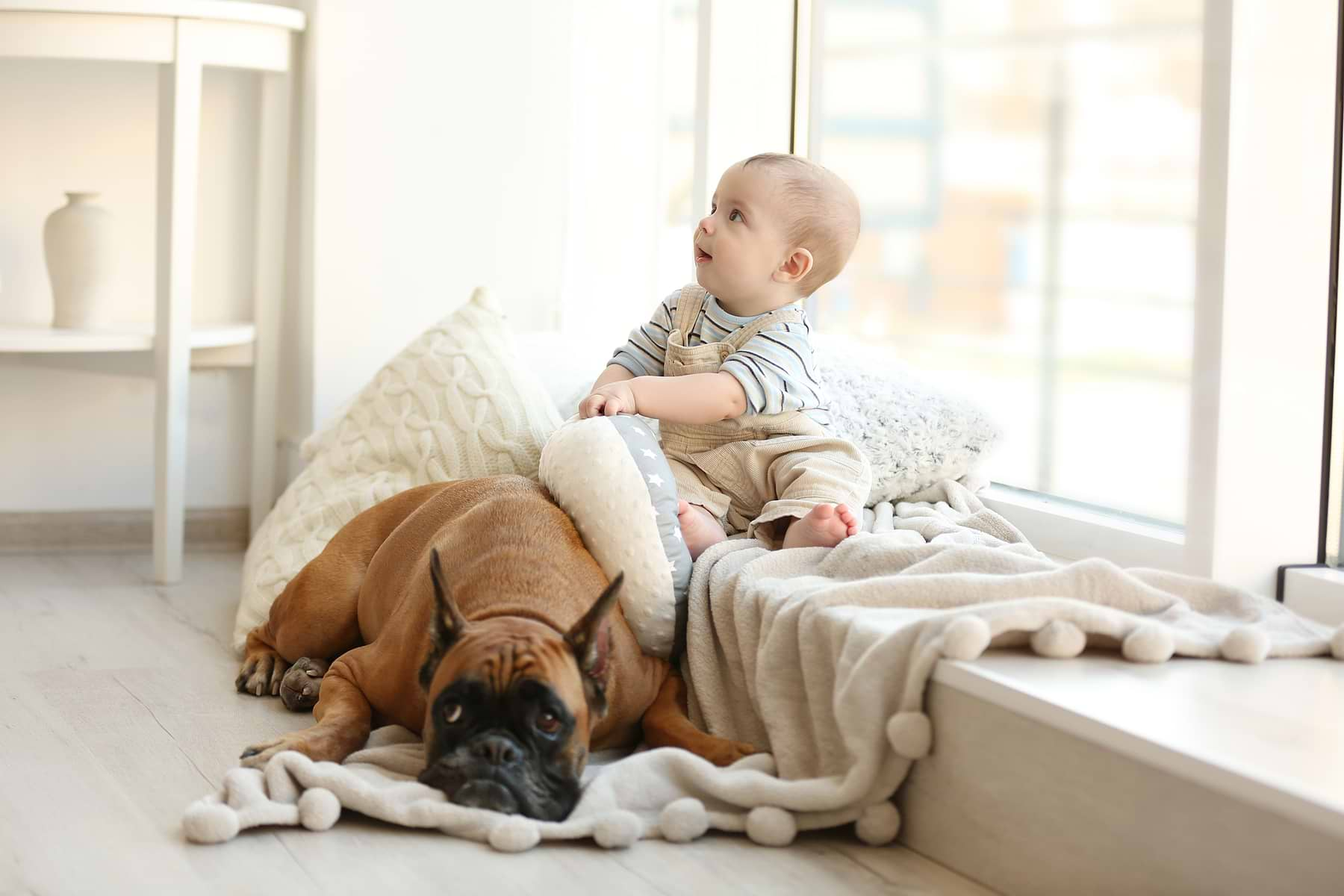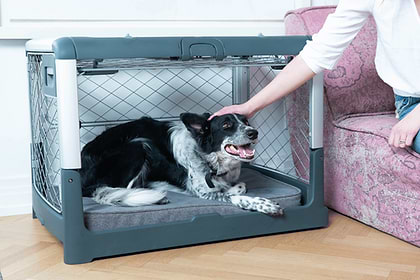Bringing a new baby home is incredibly exciting for the whole family, but big changes can be difficult for your dog. Here are tips to keep in mind when introducing your fur baby to your human baby.
1. Crate Train Your Dog Ahead of Time
Crate training your pooch has a plethora of benefits for your pet, the pet parents, and any human children. A crate is your dog’s safe haven — somewhere that they can always go to be alone and regroup. No matter how much preparation you do, bringing home a new baby will always result in a significant change in your dog’s behavior, as any animal behaviorist or professional dog trainer will tell you. Having a crate means that your dog has a place to calm down that is all theirs.
The benefits of crate training go beyond just that, however. Once you bring your child home, there will likely be times when your dog is disrupting your routine with your child. This could be intentional or unintentional on your dog’s part, but being able to tell them to go to their crate makes a world of difference.
Teach them a basic command like “go home” or “go to your crate” long before bringing home your new baby, and continue to positively reinforce the dog bed as a daily routine as time goes on. Having this trick in your back pocket can be immensely helpful, especially if your furry friend is becoming overwhelmed or even nipping at your baby’s feet or chewing on baby toys and baby blankets.
Set Boundaries With Your Child
This step will be fairly difficult if you are trying to convey these ideas to a newborn, but older kids should get the message. Your dog’s crate is off-limits, no matter what. It is crucial for your dog to always feel like this safe space is theirs, and theirs alone.
Even if a child has the best of intentions, crawling into a dog’s crate with them is not a good move. It might also be smart to set up a baby gate to protect the new addition to your family.
Your dog could begin to feel threatened, which is the last thing you want when your child is around. Instead, supervise your child when they are crawling or walking around on their own. Then, as soon as they are able to understand, explain to them that they should not enter or play with the dog’s crate.
2. Introduce Your Baby’s Scent Before Bringing Them Home
Any actions that you can take to familiarize your dog with your baby before actually bringing them home are worthwhile. Introducing your baby’s scent to your dog ahead of time can be very helpful. Letting your dog sniff a blanket, onesie, or another item that has new smells should suffice.
Allow your dog to sniff the item, and possibly give them some treats at the same time to help develop a positive association. This way, your dog will learn that this scent equals positive reinforcement, setting a sturdy foundation for a lifelong friendship.
It is not always easy for new parents to sneak away and provide their dog with something that smells like their baby. In this case, recruiting a friend or family member can help.
3. Be Patient With Both Your Dog and Your Baby
Like so many other parts of parenting, patience is the name of the game. There will be times that you would rather take a well-deserved nap, but these sacrifices will pay dividends in the end. At times, your dog might need a break, or they might need more of your attention. At (many) other times, your baby will require the vast majority of your energy.
Understand that everyone is doing their best to adjust to this new situation. Your dog got used to a certain way of life, and they are still in the process of learning that this change is actually for the best. Pet parents are trying to strike the right balance between taking care of their human babies, their fur children, and themselves. Then, babies are just trying to figure out how to not poop themselves countless times a day.
4. Always Supervise Their Interactions
Even once you are confident that your dog is gentle with your baby, you should still monitor all of their interactions. Your dog might do something with completely friendly intentions that could be dangerous to a new baby. This does not mean that your dog is dangerous, it simply means that babies are delicate. After their first meeting following your baby’s arrival, keep an eye on your baby when the high chair or stroller is accessible to your dog. In addition, keep the nursery off-limits to your dog and keep your pet care area off-limits to your baby.
By supervising your dog and baby, you can ensure that they only have positive interactions with one another.
5. Keep Your Dog’s Routine as Similar as Possible to Before
Routine is incredibly important to dogs, just like it is to children (and many adults!). No matter how much you prepare ahead of time, there will be unforeseen changes that occur when you bring home a new baby. Try to keep your dog’s routine the same, or at least similar to what it was before.
Unfortunately, this is not always a realistic possibility for parents. Luckily, there are options that make it easier for everyone. By changing routines over time rather than doing so all at once, you ease your dog into the changes.
Adjust Your Routine Slowly
Dogs are creatures of habit, and as such, they seriously do not appreciate having their routines messed with. A dramatic shift in the times that they are fed or when they go out for a walk can be enough to cause them to act out. It is much better for everyone’s sake to enact these changes slowly.
Start altering your behaviors before the baby is due. For instance, if you know that your sleep schedule will change (or become nonexistent), start changing meal times a few months before bringing home your baby. Do this in small increments, so that your pet will be more comfortable with the change. Gradually moving your dog’s mealtime by fifteen minutes or a half an hour is going to make for a much more pleasant experience than changing everything all at once.
6. Give Your Dog as Much Attention as You Can
We know that this can be a daunting prospect when you have just brought home a newborn, but it is crucial to keep your dog involved. If they do not get enough cuddles and playtime, then your pet could become bored, insecure, or even develop symptoms of separation anxiety.
Your dog is inevitably going to be confused as to why they are not the center of your world anymore. After all, to them, you were always a pet parent first, so suddenly being a human parent is quite the adjustment. Many parents find it helpful to get extra assistance, especially when the responsibilities of (human) parenthood become a lot to handle.
Babies can be unpredictable, so having a backup plan is wise. Consider asking a friend or family member to dog sit, or see if there is availability at a local doggy daycare. A helping hand can make a world of difference for new parents. It takes a village!
Get Them Enough Exercise
Getting your dog enough exercise has multiple advantages. First, your dog will remain physically fit and healthy. Second, tiring out your dog makes them calm and much more relaxed during new experiences and meeting new people. Going out for a walk will help your dog to stay mentally stimulated and will also give them some quality social time with people.
That being said, make sure to never overexert your dog either. Too much exercise can come with problems of its own, so know your dog and know their limits.
7. Stay Cool, Calm, and Collected
We often underestimate just how adept our dogs really are at reading our moods, tone of voice, and even facial expressions. Their ability to understand us goes far beyond just getting excited to hear a falsetto baby voice pointed at them. Not only are dogs able to figure out what we say, but they also can correctly interpret how we say it.
People talk about how dogs are able to read the energy of the room or determine how their pet parents are feeling. There is actually a great deal of truth to this, but it is not because our dogs are psychic. Be aware of what you say around your dog, and both the facial expressions and tone you use when you say it.
If you are conveying anxiety or stress, your dog is likely to pick up on your signals. Then, your dog will probably start to feel anxious as well, since they are going off of your lead. Meanwhile, if you exude a fairly calm and collected energy, your dog will feel those soothing vibes and be much more at ease.
From Pet Parent to Human Parent
The transition from pet parent to both pet and human parent is always a significant adjustment. With understanding, patience, and preparation, you can help everyone see that this change is for the best.
Sources:
How Important Is Routine in Your Dog’s Life | PetGuide
5 Signs Your Dog Is Getting Too Much Exercise | PetMD
Their Masters’ Voices: Dogs Understand Tone and Meaning of Words: Shots | Health News: NPR

The Diggs Team
We believe our dogs deserve safer, better designed pet products.
You might also like
Crate training tips, stories and inspiration
View all blogsIn Your Diggs
Share your photos with #DiggsPet and tag us @DiggsPet on IG and TikTok.



